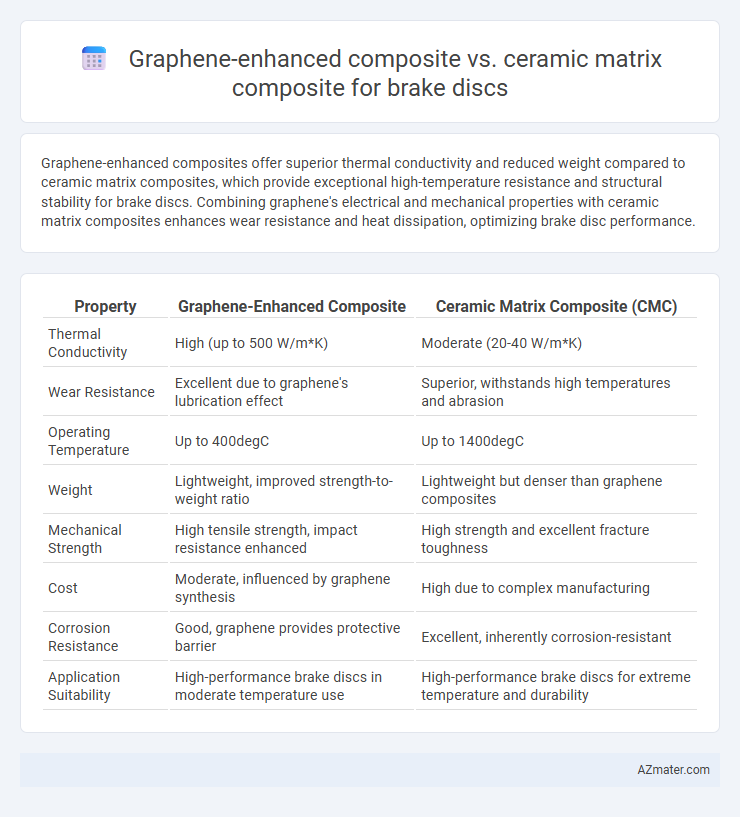Graphene-enhanced composites offer superior thermal conductivity and reduced weight compared to ceramic matrix composites, which provide exceptional high-temperature resistance and structural stability for brake discs. Combining graphene's electrical and mechanical properties with ceramic matrix composites enhances wear resistance and heat dissipation, optimizing brake disc performance.
Table of Comparison
| Property | Graphene-Enhanced Composite | Ceramic Matrix Composite (CMC) |
|---|---|---|
| Thermal Conductivity | High (up to 500 W/m*K) | Moderate (20-40 W/m*K) |
| Wear Resistance | Excellent due to graphene's lubrication effect | Superior, withstands high temperatures and abrasion |
| Operating Temperature | Up to 400degC | Up to 1400degC |
| Weight | Lightweight, improved strength-to-weight ratio | Lightweight but denser than graphene composites |
| Mechanical Strength | High tensile strength, impact resistance enhanced | High strength and excellent fracture toughness |
| Cost | Moderate, influenced by graphene synthesis | High due to complex manufacturing |
| Corrosion Resistance | Good, graphene provides protective barrier | Excellent, inherently corrosion-resistant |
| Application Suitability | High-performance brake discs in moderate temperature use | High-performance brake discs for extreme temperature and durability |
Introduction to Advanced Brake Disc Materials
Graphene-enhanced composites offer superior thermal conductivity and mechanical strength compared to traditional materials, making them ideal for high-performance brake discs. Ceramic matrix composites (CMCs) provide excellent heat resistance and wear properties, ensuring durability under extreme braking conditions. Both materials significantly improve brake disc performance by reducing weight and enhancing heat dissipation, critical for advanced automotive and aerospace applications.
Overview of Graphene-Enhanced Composites
Graphene-enhanced composites for brake discs incorporate graphene's exceptional mechanical strength, thermal conductivity, and lightweight properties to significantly improve wear resistance and heat dissipation compared to traditional ceramic matrix composites (CMCs). These composites leverage graphene's two-dimensional structure to enhance the composite matrix's toughness and reduce thermal degradation under extreme braking conditions, resulting in longer service life and improved performance. Graphene integration within polymer or metal matrices offers superior friction stability and reduced weight, making them ideal for high-performance automotive and aerospace braking systems.
Fundamentals of Ceramic Matrix Composites
Ceramic matrix composites (CMCs) consist of ceramic fibers embedded in a ceramic matrix, offering exceptional thermal stability, high strength-to-weight ratio, and enhanced fracture toughness essential for brake disc applications. Unlike graphene-enhanced composites, CMCs resist extreme temperatures and oxidative environments, making them ideal for high-performance braking systems in aerospace and motorsports. The fundamental advantage of ceramic matrix composites lies in their microstructural design that inhibits crack propagation, ensures durability under thermal cycling, and provides sustained mechanical performance.
Comparative Mechanical Properties
Graphene-enhanced composites exhibit superior tensile strength and thermal conductivity compared to ceramic matrix composites (CMCs), offering improved heat dissipation and resistance to thermal shock in brake disc applications. CMCs provide higher wear resistance and maintain structural integrity at elevated temperatures, but their brittleness can limit impact toughness relative to graphene-reinforced materials. The combination of graphene's exceptional mechanical flexibility and CMCs' hardness creates a performance trade-off essential for optimizing brake disc durability and efficiency.
Thermal Conductivity and Heat Management
Graphene-enhanced composites exhibit superior thermal conductivity compared to ceramic matrix composites (CMCs), enabling faster heat dissipation during high-speed braking scenarios. The enhanced heat management characteristics of graphene facilitate stable temperature distribution, reducing the risk of thermal degradation and brake fade. In contrast, while CMCs offer high thermal stability, their relatively lower thermal conductivity limits rapid heat transfer, potentially leading to localized hotspots under extreme conditions.
Wear Resistance and Longevity
Graphene-enhanced composites exhibit superior wear resistance in brake discs due to graphene's high mechanical strength and thermal conductivity, which effectively reduce friction and heat buildup during braking. Ceramic matrix composites offer high-temperature stability and excellent wear resistance, but their brittleness may limit longevity under impact stress compared to graphene-enhanced composites. Studies show graphene-enhanced brake discs maintain performance and structural integrity over extended cycles, resulting in longer service life than conventional ceramic matrix counterparts.
Weight and Performance Efficiency
Graphene-enhanced composites offer significantly lower weight compared to ceramic matrix composites (CMCs), improving vehicle fuel efficiency and handling due to reduced unsprung mass. Their superior thermal conductivity and mechanical strength enhance braking performance by dissipating heat faster, reducing brake fade and improving overall response. While CMCs provide excellent high-temperature resistance, graphene composites deliver a balanced combination of lightweight structure and performance efficiency, making them ideal for advanced brake disc applications.
Manufacturing Techniques and Costs
Graphene-enhanced composites for brake discs utilize advanced dispersion methods such as solution blending and in-situ polymerization to uniformly integrate graphene, resulting in improved thermal conductivity and mechanical strength while maintaining relatively low manufacturing costs. Ceramic matrix composites (CMCs), fabricated through complex processes including hot pressing, chemical vapor infiltration, and sintering, offer superior high-temperature resistance but involve significantly higher production costs due to lengthy processing times and expensive raw materials. The cost-efficiency of graphene-enhanced composites supports scalable manufacturing for automotive applications, whereas CMCs remain more suitable for high-performance or aerospace sectors where cost is less critical.
Environmental Impact and Sustainability
Graphene-enhanced composites in brake discs offer significant reductions in environmental impact due to their lightweight nature, which improves fuel efficiency and lowers CO2 emissions compared to traditional materials. Ceramic matrix composites (CMCs) provide exceptional high-temperature resistance and durability, resulting in longer brake disc lifespans and less frequent replacements, thereby reducing waste and resource consumption. The integration of graphene enhances recyclability and supports sustainable manufacturing processes, while CMCs contribute to sustainability by minimizing thermal degradation and ensuring consistent performance under extreme conditions.
Future Trends in Brake Disc Technology
Graphene-enhanced composites exhibit superior thermal conductivity and lightweight properties, making them promising candidates for next-generation brake discs with improved heat dissipation and reduced wear. Ceramic matrix composites (CMC) offer exceptional high-temperature resistance and structural durability, crucial for high-performance braking systems in extreme conditions. Future trends indicate a hybridization approach combining graphene's electrical and thermal advantages with the robust mechanical properties of CMCs to create brake discs that enhance safety, longevity, and efficiency in electric and high-speed vehicles.

Infographic: Graphene-enhanced composite vs Ceramic matrix composite for Brake disc
 azmater.com
azmater.com